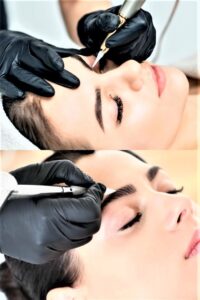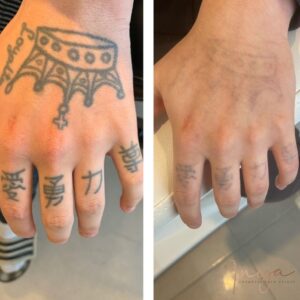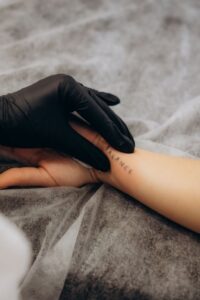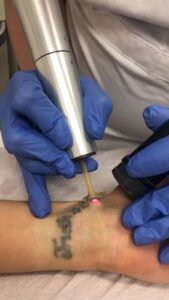- Introduction
- Brief overview of tattoo removal
- Importance of understanding the tattoo removal healing process
- What is the Tattoo Removal Healing Process?
- Definition and significance
- The Different Stages of the Tattoo Removal Healing Process
- H2: Immediate Aftercare
- H3: First 24 Hours
- H3: First Week
- H2: Mid-Term Healing
- H3: Week 2 to Week 4
- H2: Long-Term Healing
- H3: Month 2 to Month 6
- Factors Affecting the Tattoo Removal Healing Process
- Skin type
- Tattoo characteristics
- Removal method
- H2: Immediate Aftercare
- Common Symptoms During the Tattoo Removal Healing Process
- Redness
- Swelling
- Scabbing
- Itching
- Best Practices for a Smooth Tattoo Removal Healing Process
- Proper hygiene
- Moisturization
- Avoiding sun exposure
- What to Avoid During the Tattoo Removal Healing Process
- Scratching or picking at the area
- Excessive physical activity
- Applying harsh chemicals
- Diet and Nutrition for Optimizing the Tattoo Removal Healing Process
- Importance of hydration
- Foods rich in vitamins and minerals
- Potential Complications in the Tattoo Removal Healing Process
- Infection
- Scarring
- Hyperpigmentation
- When to Consult a Professional During the Tattoo Removal Healing Process
- Signs of infection
- Unusual symptoms
- Tips for Managing Pain During the Tattoo Removal Healing Process
- Over-the-counter pain relievers
- Cold compresses
- The Role of Follow-Up Appointments in the Tattoo Removal Healing Process
- Monitoring progress
- Adjusting treatment plans
- Conclusion
- Recap of key points
- Encouragement for patience and proper care
- Additional Resources
- Links to helpful websites and articles
- Contact information for professional advice

Tattoo Removal Healing Process: A Comprehensive Guide #Tattoo Removal Healing Process
Introduction
Tattoo removal can be a transformative experience, whether you’re looking to erase a past mistake or make room for new art. Understanding the tattoo removal healing process is crucial for ensuring the best possible outcome. This guide will walk you through everything you need to know about the tattoo removal process.
Different Stages
Immediate Aftercare
First 24 Hours
Right after your tattoo removal session, your skin will be sensitive and may appear red and swollen. It’s essential to keep the area clean and covered with a sterile bandage to prevent infection.
First Week #Tattoo Removal Healing Process
During the first week, you may notice scabbing and peeling. This is a normal part of the tattoo removal process. Keep the area moisturized with a gentle, fragrance-free lotion to aid in healing.
Mid-Term Healing
Week 2 to Week 4
As you enter the second week, the initial redness and swelling should begin to subside. However, the area may still be tender, and scabs may persist. Avoid picking at the scabs to prevent scarring.
Long-Term Healing
Month 2 to Month 6
The long-term healing stage is where your skin continues to repair itself. It may take several months for your skin to fully recover, and during this time, it’s crucial to protect the area from sun exposure and keep it moisturized.

Factors Affecting the Tattoo Removal Process #Tattoo Removal Healing Process
Several factors can influence how your skin heals after tattoo removal. These include:
- Skin type: Different skin types react differently to tattoo removal treatments.
- Tattoo characteristics: The size, color, and age of your tattoo can affect the healing process.
- Removal method: Various removal methods, such as laser treatment or excision, can impact the healing timeline.
Common Symptoms During the Tattoo Removal Process
It’s normal to experience certain symptoms during the tattoo removal healing process, including:
- Redness: Mild redness is common and usually subsides within a few days.
- Swelling: Swelling can occur but should decrease over time.
- Scabbing: Scabs form as part of the natural healing process.
- Itching: Itching is a sign of healing, but avoid scratching the area to prevent infection.
Best Practices for a Smooth Tattoo Removal Healing Process
To ensure a smooth tattoo removal healing process, follow these best practices:
- Proper hygiene: Keep the area clean to prevent infection.
- Moisturization: Apply a gentle, fragrance-free moisturizer to keep the skin hydrated.
- Avoiding sun exposure: Protect the area from direct sunlight to prevent further damage.
What to Avoid During the Tattoo Removal Healing Process
Certain activities can hinder the tattoo removal healing process, so it’s important to avoid:
- Scratching or picking at the area: This can lead to infection and scarring.
- Excessive physical activity: Intense exercise can cause sweating and irritation.
- Applying harsh chemicals: Avoid using products that can irritate the healing skin.
Diet and Nutrition for Optimizing the Tattoo Removal Healing Process
A healthy diet can support the tattoo removal healing process. Focus on:
- Hydration: Drink plenty of water to keep your skin hydrated.
- Foods rich in vitamins and minerals: Nutrients like vitamins C and E can promote skin healing.
Potential Complications in the Tattoo Removal Healing Process
While complications are rare, they can occur. Be aware of potential issues such as:
- Infection: Signs include increased redness, warmth, and pus.
- Scarring: Improper care can lead to permanent scars.
- Hyperpigmentation: Dark spots may develop as the skin heals.
When to Consult a Professional During the Tattoo Removal Healing Process
If you notice any unusual symptoms or signs of infection, it’s important to seek professional advice. This includes:
- Signs of infection: Persistent redness, swelling, or pus.
- Unusual symptoms: Severe pain, excessive scabbing, or blistering.
Tips for Managing Pain During the Tattoo Removal Healing Process
Pain is a common part of the tattoo removal healing process, but it can be managed with:
- Over-the-counter pain relievers: Medications like ibuprofen can help reduce discomfort.
- Cold compresses: Applying a cold compress can soothe the area and reduce swelling.
The Role of Follow-Up Appointments in the Tattoo Removal Healing Process
Regular follow-up appointments are crucial for monitoring your progress and adjusting your treatment plan as needed. Your professional can provide personalized advice and ensure that the tattoo removal healing process is on track.

FAQs About the Tattoo Removal Healing Process
How long does the healing process take? #Tattoo Removal Healing Process
The tattoo removal healing process can take several months, depending on factors like skin type and tattoo characteristics.
Can I speed up the healing process?
While you can’t rush the healing process, following proper aftercare can promote faster recovery.
What should I do if I experience severe pain?
If you experience severe pain, consult a professional for advice. Over-the-counter pain relievers and cold compresses can also help.
Are there any products that can help? #Tattoo Removal Healing Process
Fragrance-free moisturizers and products recommended by your removal specialist can aid in the healing process.
Is it normal to have scabs?
Yes, scabbing is a normal part of the tattoo removal healing process. Avoid picking at them to prevent scarring.
Conclusion
The tattoo removal healing process is a journey that requires patience and proper care. By understanding the stages of healing, following best practices, and knowing when to seek professional advice, you can ensure a smooth recovery and achieve the best possible results.
A Comprehensive Guide
Introduction
Tattoo removal can be a transformative experience, whether you’re looking to erase a past mistake or make room for new art. Understanding the tattoo removal healing process is crucial for ensuring the best possible outcome. This guide will walk you through everything you need to know about the tattoo removal healing process.
What is the Tattoo Removal Healing Process?
The tattoo removal process refers to the body’s natural response to the removal of tattoo ink. This involves a series of stages that your skin goes through to recover and regenerate after the removal treatment. Knowing what to expect can help you take better care of your skin and avoid potential complications.

The Different Stages of the Tattoo Removal Healing #Tattoo Removal Healing Process
Immediate Aftercare
First 24 Hours
Right after your tattoo removal session, your skin will be sensitive and may appear red and swollen. It’s essential to keep the area clean and covered with a sterile bandage to prevent infection.
First Week
During the first week, you may notice scabbing and peeling. This is a normal part of the tattoo removal process. Keep the area moisturized with a gentle, fragrance-free lotion to aid in healing.
Mid-Term Healing
Week 2 to Week 4
As you enter the second week, the initial redness and swelling should begin to subside. However, the area may still be tender, and scabs may persist. Avoid picking at the scabs to prevent scarring.
Long-Term Healing
Month 2 to Month 6
The long-term healing stage is where your skin continues to repair itself. It may take several months for your skin to fully recover, and during this time, it’s crucial to protect the area from sun exposure and keep it moisturized.
Factors Affecting
Several factors can influence how your skin heals after tattoo removal. These include:
- Skin type: Different skin types react differently to tattoo removal treatments.
- Tattoo characteristics: The size, color, and age of your tattoo can affect the healing process.
- Removal method: Various removal methods, such as laser treatment or excision, can impact the healing timeline.
Common Symptoms
It’s normal to experience certain symptoms during the tattoo removal healing process, including:
- Redness: Mild redness is common and usually subsides within a few days.
- Swelling: Swelling can occur but should decrease over time.
- Scabbing: Scabs form as part of the natural healing process.
- Itching: Itching is a sign of healing, but avoid scratching the area to prevent infection.
Best Practices for a Smooth Tattoo Removal Process
To ensure a smooth tattoo removal healing process, follow these best practices:
- Proper hygiene: Keep the area clean to prevent infection.
- Moisturization: Apply a gentle, fragrance-free moisturizer to keep the skin hydrated.
- Avoiding sun exposure: Protect the area from direct sunlight to prevent further damage.
What to Avoid During the Tattoo Removal Process
Certain activities can hinder the tattoo removal healing process, so it’s important to avoid:
- Scratching or picking at the area: This can lead to infection and scarring.
- Excessive physical activity: Intense exercise can cause sweating and irritation.
- Applying harsh chemicals: Avoid using products that can irritate the healing skin.
Diet and Nutrition for Optimizing
A healthy diet can support the tattoo removal healing process. Focus on:
- Hydration: Drink plenty of water to keep your skin hydrated.
- Foods rich in vitamins and minerals: Nutrients like vitamins C and E can promote skin healing.
Potential Complications in the Tattoo Removal Process
While complications are rare, they can occur. Be aware of potential issues such as:
- Infection: Signs include increased redness, warmth, and pus.
- Scarring: Improper care can lead to permanent scars.
- Hyperpigmentation: Dark spots may develop as the skin heals.
When to Consult a Professional During the Tattoo Removal Healing Process
If you notice any unusual symptoms or signs of infection, it’s important to seek professional advice. This includes:
- Signs of infection: Persistent redness, swelling, or pus.
- Unusual symptoms: Severe pain, excessive scabbing, or blistering.
Tips for Managing Pain During the Tattoo Removal Healing Process
Pain is a common part of the tattoo removal healing process, but it can be managed with:
- Over-the-counter pain relievers: Medications like ibuprofen can help reduce discomfort.
- Cold compresses: Applying a cold compress can soothe the area and reduce swelling.
The Role of Follow-Up Appointments in the Tattoo Removal Healing Process
Regular follow-up appointments are crucial for monitoring your progress and adjusting your treatment plan as needed. Your professional can provide personalized advice and ensure that the tattoo removal healing process is on track.
Positive Aspects of the Tattoo Removal Process
Understanding the positive aspects of the tattoo removal healing process can help you stay motivated and optimistic. These include:
- Visible Progress: As the healing process progresses, you’ll notice a significant reduction in the tattoo’s appearance, which can be very encouraging.
- Skin Regeneration: The process stimulates your skin’s natural healing and regeneration, leading to healthier skin over time.
- Confidence Boost: Successfully removing a tattoo can boost your confidence and self-esteem, especially if the tattoo was a source of regret.
Negative Aspects of the Tattoo Removal Process
It’s also important to be aware of the potential negative aspects of the tattoo removal healing process so you can manage your expectations:
- Discomfort: The process can be uncomfortable, with symptoms like redness, swelling, and itching being common.
- Time-Consuming: The healing process can be lengthy, requiring patience and consistent care.
- Risk of Complications: There is a risk of complications such as infection, scarring, and hyperpigmentation, which can affect the outcome.
FAQs About the Tattoo Removal Process
How long does the healing process take?
The tattoo removal process can take several months, depending on factors like skin type and tattoo characteristics.
Can I speed up the healing process?
While you can’t rush the healing process, following proper aftercare can promote faster recovery.
What should I do if I experience severe pain?
If you experience severe pain, consult a professional for advice. Over-the-counter pain relievers and cold compresses can also help.
Are there any products that can help?
Fragrance-free moisturizers and products recommended by your removal specialist can aid in the healing process.
Is it normal to have scabs?
Yes, scabbing is a normal part of the tattoo removal healing process. Avoid picking at them to prevent scarring.
Conclusion
The tattoo removal healing is a journey that requires patience and proper care. By understanding the stages of healing, following best practices, and knowing when to seek professional advice, you can ensure a smooth recovery and achieve the best possible results.
Additional Resources
For more information on the tattoo removal healing process, check out these helpful websites and articles. If you have any concerns, don’t hesitate to contact a professional for personalized advice.